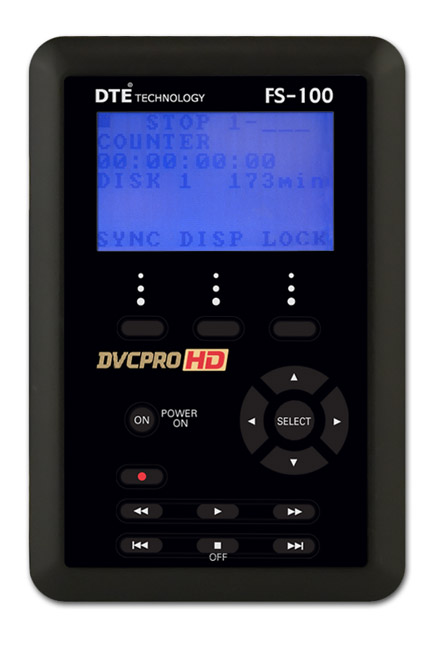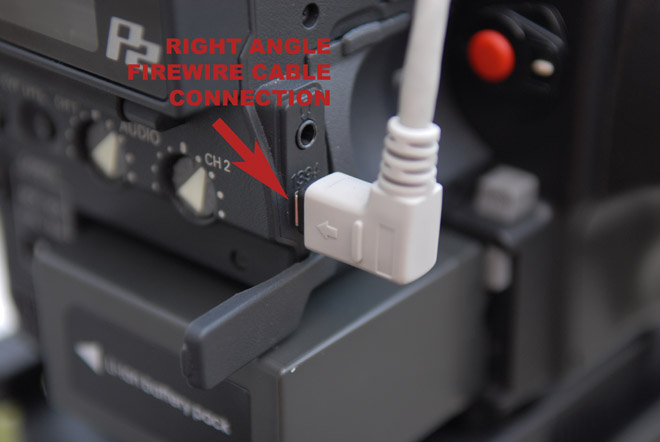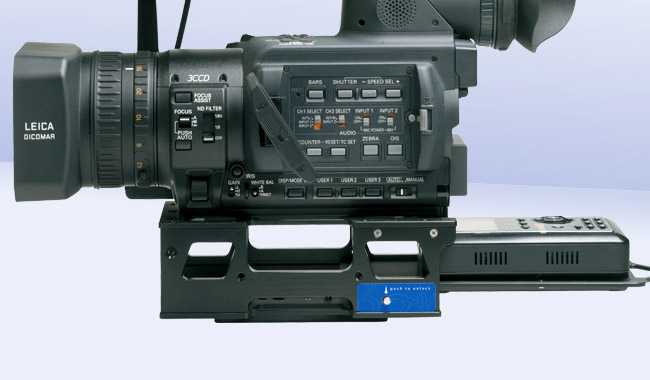While Panasonic's HVX-200
camcorder redefined workflow for acquiring high definition
video, it presented new challenges as well, particularly for
long form acquisition. Many shooters viewed solid-state p2 (professional
plug-in) cards as more efficient than tape. However the cards
were scarce in the first months following the cam's release,
and have remained pricey. In addition, capturing more than a
few minutes of continuous footage required multiple p2
cards, offloading to a Panasonic
p2 Store, PC Card laptop slot, or shutting down the cam to
transfer the footage to a computer using either USB2 or Firewire.
None of these options were particularly compatible with shooting
continuous footage.
Focus Enhancements' FS-100, a 100-gigabyte
device that records video footage directly to a hard drive, changed
this equation. The battery-powered device is founded on the company's
previous portable hard drive solutions and is the first to work
in DVCProHD footage. Once charged and connected to the HVX200
firewire port, it records SD and DVCProHD footage in every format
except pNative using firmware v.2.0.3. More on that later. DTE®
products from Focus were proven technology, and the FS-100 was
no exception.
Early issues with dropouts and reliability
have been addressed with a series of firmware upgrades, which
also streamlined menus and added features. The latest revision,
firmware 3.0, adds the equivalent of pNative DVCProHD MXF acquisition,
and the ability to capture DVCProHD footage in QuickTime native
formats. This permits over three (3) hours of continuous DVCProHD
capture, and almost immediate use of the footage in your editing
application. The device is rugged, versatile, and designed to
work directly with the HVX200. Using the FS-100 requires attention
to detail, however, as does every recording device.
Out of the Box.
A shipped FS-100 package consists of the DTE 100 GB drive, a
one-foot 4- to 6-pin firewire cable, stock battery, charger,
belt clip, and 106-page manual. A downloadable PDF manual is
available at Focus's web site. The firewire cable I received
uses a straight 4-pin plug to connect to the cam, and a 6-pin
plug for connecting to the FS-100. Focus now ships the FW cable
with a right angle 4-pin plug to connect more securely the cam.
The manual while informative and illustrated, is not a picture
of clarity. A shooter needs to spend some time with it to learn
both the basic and esoteric capabilities of the FS-100.
The device is housed in a blocky, plastic
case the same color as the HVX200. Its dimensions are 1.6 x 5.6
x 3.7"and it weighs in at one pound. No doubt shooters would
prefer a smaller, more efficient enclosure similar to the iPod.
But this device utilizes a 2.5-inch hard drive and sophisticated
electronics -- not the smaller, lower capacity and slower 1.8
inch drives used in video iPods.
The LCD screen, while large and bright,
is a different matter. Both the text display and menu system
should be improved to ease navigation and make menu choices more
intuitive. Menu text is unattractive, and navigation can be cumbersome.
In this regard, Focus might draw some inspiration from the iPod.
Choices and navigation need to be economized, and the graphics
should be improved. This is an ergonomic issue that doesn't affect
performance, however.

The 90-minute battery attached snugly
to the unit, and took slightly less than three hours to charge.
Orange or green lights on the unit monitor battery charging.
The stock battery, in my testing, offered a little more than
an hour of run time, and HVX200 batteries will not work with
the FS-100. Focus's extended battery runs a claimed three hours,
and costs $200.00. I wish Focus would ship the extended battery
with all units. However, there are a third party solutions for
extended battery run times at lower prices, which I will address
later.
Although the FS-100 records to SD and
several NLE editing specific formats, it is specifically targeted
for the HVX-200. To get it up and running, first set the HVX-200
to its p2 mode, and 1394 Control to "Both" to record
to p2 cards and the FS-100 simultaneous. Otherwise, use the "Ext."
to record exclusively to the FS-100. Set the FS-100 to "Tapeless"
in its "Control" Menu, and then you are in for a pleasant
surprise.
Firmware v.3.0 Improvements. Focus's v.3 firmware for the FS-100 provides
significant new functionality to the FS-100. One new feature
enables it to record the equivalent of native MXF for DVCProHD
720p24, 25 and 30. 1080i acquisition in this format is not currently
supported, nor does the device provide for variable frame rates.
Only the required frames are recorded in the native modes, which
eliminates having to remove advanced pull down or duplicate frames
when importing into your editing software.
There is an additional bonus to economize
workflow for Final Cut Pro users. DVCProHD 720 and 1080 footage
can be directly captured in native QuickTime format that is the
functional equivalent of native frame rates. Gone are two steps
in the import process: the need to organize the p2 data and to
use the p2 import feature of Final Cut Pro. Note that the HVX-200
cannot output a pNative stream via its Firewire port, so do not
choose this setting in the cam. Elect the appropriate non pNative
setting. And up to four channels of QuickTime digital audio support
has been added. The revised firmware is included with all FS-100s
manufactured after February 1, 2007, and is available for a modest
$39.95 at the company's
web site. Instructions for applying the firmware are included
in the manual.
Menus.
There are plenty, and many are not particularly self-explanatory.
On the plus side, some menu choices don't pertain to HVX-200
users and others help HVX-200 users streamline workflow. For
example, the Reels function enables a shooter to save captures
to user-defined folders on the FS-100. There is a loop control
to record footage to defined lengths, and programmable buttons
to recall frequently needed screens. A prerecord function caches
footage for a preset time interval even when not recording. Up
to six (6) seconds of HD footage can be captured to the prerecord
cache. The point being that the FS-100 can be set in numerous
ways to meet your shooting requirements.
If there is room for improvement in this
area, it lies in menu navigation and appearance. The LCD is big
and bright, but the onscreen text is succinct and basic. There
are better navigation roadmaps and displays on iPod-like devices
and cellular telephones. I am a believer in functional ergonomics,
and Focus is urged to improve the menus.
Firewire Connections. I was initially concerned with how secure the
two Firewire connections were while recording. A related concern
was protecting the exposed (and delicate) link between the cable
and the HVX200 FW port. These concerns arise when the devices
are jostled, or when attaching or removing the firewire cable.
I experienced no firewire disconnects
while shooting that I can directly attribute to jostling or movement.
However, the FS-100 is finicky when turning record on and off
quickly in the cam. You will likely and briefly loose a connection
doing that. However, the real concern is the durability of the
4-pin FW connection to the cam. Focus acknowledges that the connection
is exposed and delicate. If this concerns you, there are a couple
of options. You can restrain the cable to the camera by looping
it through the handle. Or you can buy a right angle 4-pin FW
connector that faces downward if your FS-100 didn't ship with
one. Other FS-100 owners attach Velcro straps (Peavey is recommended)
to better secure the 4-pin FW plug to the cam.

In all fairness to this review, Focus
has no control over the choice or placement of the 4-pin Firewire
port on the HVX200. Camera manufacturers seem to gravitate to
the smaller and less robust 4-pin Firewire connection rather
than studier 6-pin plug/port. However, FS-100 users should be
aware of the issue and take preventative steps to minimize damage
to the port, cam, and FS-100. An ounce of prevention is worth
a pound of cure, so the saying goes.
Accessories.
The device ships with a plastic belt mount clip that attaches
to the FS-100 and your belt loop. Extended batteries, camera
mount kits, and battery chargers are available from Focus and
third parties on the web. Focus's FS-100 Camera Mount Kit includes
a plastic cradle, metal swivel mount, and 12" 6- to 4-pin
Firewire cable.
The JimmyBox
II camera mount (see lafcpug
review) both works well the FS-100, while originally designed
to house audio receivers, adapts well as an under cam FS-100
mount. A similar mount called the cage FS-100 is available from
geardear.com, and screws into
the thread on the grip of your camera. The Focus camera mount
system attaches to the top of the cam. Another excellent but
pricier option is the redesigned under cam Box-FS fastening system from bebob. (see
lafcpug review) Promised options for this device expand its
use.

JimmyBox II camera mount

Box-FS fastening system from bebob .
You can purchase an extended battery
directly from Focus, or use third party power supplies like the
Tekkeon MP3400 MyPower external battery, which can last up to
2.5 hours.
Considerations.
My take on the ruggedness of the device combines my experience
and what I've read elsewhere. I've read numerous posts on field
use and most are encouraging in both mundane and demanding environments.
The FS-100 comes with a two-year warranty, which is longer than
industry standard. However, the device is essentially a hard
drive, and it should be treated carefully as with any similar
type component. I asked Focus to estimate its longevity, and
the company provides the following specs: Load/Unload cycle -
600,000; Power on hours (POH) per month - 730; Availability -
24x7, which are typical of most better hard drives. In nearly
three months of use, it never exhibited a problem for me.
Summing Up.
With the release of v.3.0, the FS-100 provides some increased
functionality, and impressive capabilities. Recording directly
to QuickTime in a variety of functionally equivalent pNative
QuickTime formats, further economizes getting footage to your
computer for Final Cut Pro users. Although 1080i p2 MXF and VFR
are yet unsupported, Focus has a track record of listening to
its user base in determining future firmware updates. Most gripes
I had with the FS-100 relate to menu appearance and navigation,
and streamlining the various functions of the FS-100. Users should
also take notice of the exposed 4-pin Firewire connection on
the cam when shooting, transporting, and plugging/unplugging
the device. Each of these concerns requires care, attention,
and some accommodations. However, the device provides new and
economized options for long form DVCProHD acquisition in a form
factor that works.
DTE® (direct-to-edit) is a registered
trademark of Focus Enhancements. All other trademarks are property
of the respective owners.
Copyright ©2007 David
A. Saraceno
David
A. Saraceno is a motion graphics
artist located in Spokane, Washington. He has written for DV
Magazine, AV Video, MacHome Journal, and several state and national
legal technology magazines. David also moderates several forums
on 2-pop.com.